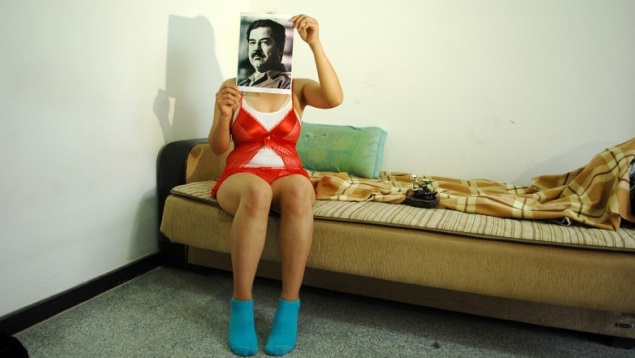Lida Abdul, Rita Duffy, Jamal Penjweny: White – Lest we Forget

In this year where World War One is at the forefront of memory, and where we are exhorted to remember those who paid the ultimate price for their country and their beliefs, this exhibition joins those paying homage by looking at how war continues in this day, and how the lives of ordinary people go on after battle has raged.
Three Artists: Rita Duffy, Jamal Penjweny, Lida Abdul – show many different faces of war, united under the title WHITE – a compassionate colour, an absence of colour, a purity which is lost forever. The evocation of the White handkerchief by Rita Duffy in her Cloth paintings is forever and immediately reminiscent of Fr. Edward Daly crossing over battle lines with the wounded of Derry’s Bloody Sunday; Jamal Penjweny places Saddam Hussein on the white paper in front of faces in SADDAM IS HERE – his message is both prescient for Iraq today as well as delving into the psychology of dictatorship. Lida Abdul evokes the scarred terrain of Afghanistan with her THE WHITE HOUSE, a shocking landscape of white intensity, and looks at the impact of war on women.
Following from the commemoration of the Dublin Lockout 1913-2013, LCGA continues to look at the past and contemplate the impact of major events in history in terms of how people continue to feel impact in the present, wondering about the role of commemoration as a political and social ritual. The imperative to remember is tempered by the complexity of knowing what actual history is; asking artists to respond to their own times and not history provides a truthful course of action in this act of commemoration. WHITE looks at bodies of work by artists contemporaneous with their times.
Rita Duffy was born in 1959 in Belfast. She received a B.A. at the Art & Design Centre and a M.A. in Fine Art at the University of Ulster. She is one of Northern Ireland’s groundbreaking artists who began her work concentrating primarily on the figurative/narrative tradition.
Her art is often autobiographical, including themes and images of Irish identity, history and politics. Duffy’s work has grown and evolved but remains intensely personal with overtones of the surreal. Homage is paid to the language of magic realism and always there is exquisite crafting of materials. She has initiated several major collaborative art projects and was made an Honorary Member of the R.S.U.A. for her developmental work within the built environment. She is an associate at the Goldsmiths College, London and is currently working on an artistic exchange with Argentina and N. Ireland, looking at the role art has in post conflict societies.
Her Belfast studio practice continues to develop and her public art projects are increasingly preoccupied with international themes. Currently she is developing a series of new works for the Public Records Office of N.I. which is designed into the new building. Duffy’s work is being increasingly collected at home and abroad with work in numerous public and private collections.
Jamal Penjweny is an Iraqi Kurdish photographer, artist and film maker. He started as a sculptor and painter in Iraqi Kurdistan. Since 2004, while based in Baghdad, he has reported the Iraqi Conflict all over the world and appeared in many publications, including the New York Times, The Washington Post, National Geographic among others. His latest work as a filmmaker include ‘The Gun Market’ and‘Another life’ reporting the life of smugglers and the illegal weapons trade at the border between Iraq and Iran, the place where he was born. His photography series ‘Iraq is Flying’ has been exhibited in the United Kingdom, United States, Dubai, New Zealand, Brazil and China. In 2011, Penjweny was selected by the Musée du Quai Branly as one of the best 20 non European artists. ‘Saddam is here’ has been exhibited at the Photoquai, the Paris based Photography Biennale. In his latest project, ‘The New Leaders’ Penjweny has reported the historical changes engulfing the Middle East region in the aftermath of the popular uprising. Penjweny represented Iraq in the 2013 Venice Biennale.
With thanks to Ruya Foundation for Contemporary Culture in Iraq (RUYA)
Lida Abdul As an artist who works both in performance and video art, Lida Abdul creates poetic spaces that allow the viewer to interrogate the familiar and the personal. Her work is guided by a ritualized formalism that insinuates the immediacy of myth and the playfulness of a mind seeking to understand the surrounding world. In many ways, witnessing her pieces is like attempting to understand the riddles of the gestures and the repetitions that highlight her work. Abdul’s work is located at the intersection between art and architecture; it invites the viewer to see the unfolding of new forms but never resolves the contradictions and the paradoxes, the purpose of which seems to be to make us doubt our claims of understanding. Born in Kabul, Afghanistan in 1973, and resides there now. Abdul lived in Germany and India as a refugee after she was forced to leave Afghanistan after the former-Soviet invasion. Her work fuses the tropes of ‘Western” formalism with the numerous aesthetic traditions-Islamic, Buddhist, Hindu, pagan and nomadic–that collectively influenced Afghan art and culture. She has produced work in many media including video, film, photography, installation and live performance. Her most recent work has been featured at the Venice Biennale 2005, Istanbul Modern, Kunsthalle Vienna, Museum of Modern Art Arnhem, Netherlands and Miami Central, CAC Centre d’Art Contemporain de Bretigny, and Frac Lorraine Metz, France. She has also exhibited in festivals in Mexico, Spain, Germany, Uzbekistan, Kyrgyzstan and Afghanistan; she was also a featured artist at the Central Asian Biennial 2004. For the past few years, Abdul has been working in different parts of Afghanistan on projects exploring the relationship between architecture and identity.
With thanks to Gallery Giorgio Persano, Torino, Italy
